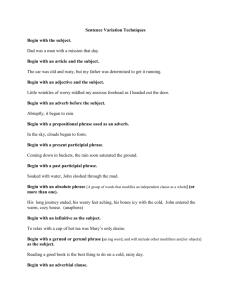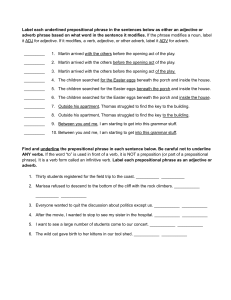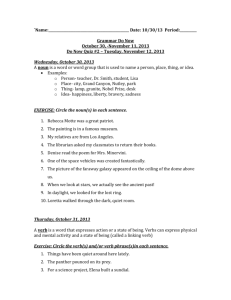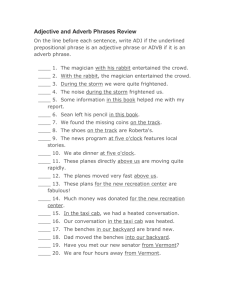click here
advertisement
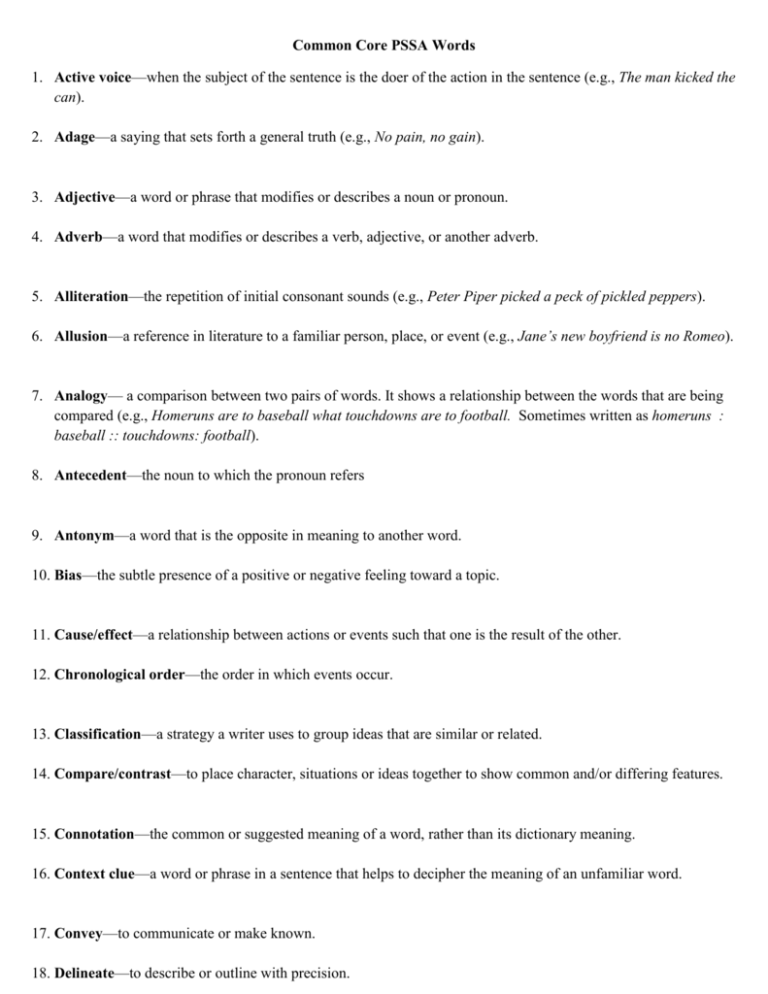
Common Core PSSA Words 1. Active voice—when the subject of the sentence is the doer of the action in the sentence (e.g., The man kicked the can). 2. Adage—a saying that sets forth a general truth (e.g., No pain, no gain). 3. Adjective—a word or phrase that modifies or describes a noun or pronoun. 4. Adverb—a word that modifies or describes a verb, adjective, or another adverb. 5. Alliteration—the repetition of initial consonant sounds (e.g., Peter Piper picked a peck of pickled peppers). 6. Allusion—a reference in literature to a familiar person, place, or event (e.g., Jane’s new boyfriend is no Romeo). 7. Analogy— a comparison between two pairs of words. It shows a relationship between the words that are being compared (e.g., Homeruns are to baseball what touchdowns are to football. Sometimes written as homeruns : baseball :: touchdowns: football). 8. Antecedent—the noun to which the pronoun refers 9. Antonym—a word that is the opposite in meaning to another word. 10. Bias—the subtle presence of a positive or negative feeling toward a topic. 11. Cause/effect—a relationship between actions or events such that one is the result of the other. 12. Chronological order—the order in which events occur. 13. Classification—a strategy a writer uses to group ideas that are similar or related. 14. Compare/contrast—to place character, situations or ideas together to show common and/or differing features. 15. Connotation—the common or suggested meaning of a word, rather than its dictionary meaning. 16. Context clue—a word or phrase in a sentence that helps to decipher the meaning of an unfamiliar word. 17. Convey—to communicate or make known. 18. Delineate—to describe or outline with precision. 19. Denotation—the dictionary meaning of a word. 20. Dialogue—conversation between characters in a literary work (e.g., “Language arts is my favorite subject,” John said. “Mine, too!” Mary answered.) 21. Elaborate/elaboration—expressing an idea or thought at greater length or in greater detail. 22. Evaluate—to examine and judge carefully. 23. Explicit—clearly expressed or fully stated in the text. 24. Fable—a brief story that illustrates human character traits through animal characters or animated objects and teaches a life lesson. 25. Fact—a piece of information that can be proven as true. 26. First person—point of view as perceived by a single character. Uses the pronouns I, me, or my. 27. Generalization—a conclusion drawn from specific information that is used to make a broad statement about a topic or person (e.g., All teenagers are irresponsible). 28. Genre—a category used to classify literary works (e.g., romance, science fiction, fantasy). 29. Gerund—the –ing form of a verb used as a noun (e.g., Running is my favorite form of exercise). 30. Homograph—two or more words that are spelled the same but have different meanings and sometimes different pronunciations (e.g., bow and bow). 31. Hyperbole—an extreme exaggeration (e.g., I’m so hungry I could eat a horse). 32. Idiom—an expression that cannot be understood from the individual meanings of the words (e.g., It’s raining cats and dogs). 33. Illustrate—to clarify by using examples. 34. Inference—a judgment based on reasoning rather than a direct statement. 35. Infinitive—the word to plus a verb (e.g., to swim, to read, to run). 36. Irony—the use of a word or phrase to mean the exact opposite of its literal meaning (e.g., I love when we have pop quizzes!). 37. Irrelevant—not relating to or supporting the issue at hand. 38. Judgment—an opinion formed or a decision made after careful consideration. 39. Memoir—a type of literary nonfiction based on the personal experiences of the author. 40. Metaphor—the comparison of two unlike things saying that one thing is the other (e.g., My love is a rose). 41. Modifier—an adjective, adverb, phrase, or clause that describes/modifies other words in the sentence. 42. Myth—a story that tries to explain the origin of the world or natural phenomena. Usually contains gods or supernatural beings. 43. Narrative writing—writing that conveys experiences, either real or imaginary. 44. Narrator—the person telling the story. 45. Nuance—a subtle or slight degree of difference. 46. Objective—not influenced by personal feelings or interpretations; unbiased; based on fact. 47. Opinion—a personal view or attitude. 48. Parenthetical element—a word, words, or a phrase added to a sentence as an explanation, comment, or qualifier, often interrupting the flow of the sentence. 49. Passive voice—when the subject of the sentence receives the action of the verb (e.g., The man was struck by lightning). 50. Personification—when animals or non-living things are given human qualities (e.g., The flowers danced across the lawn). 51. Plot—the sequence of events of a story. The structure includes: exposition, inciting incident, rising action, climax, falling action, and resolution. 52. Problem/solution—a type of text structure in which a difficulty is identified and then resolutions are proposed. 53. Pronoun-antecedent agreement—a grammatical rule stating that a pronoun must agree with its antecedent in number and person. 54. Proverb—a saying that reflects truth and wisdom and has practical application to everyday life (e.g., Two wrongs don’t make a right). 55. Pun—a humorous way of using a word or phrase so that more than one meaning is suggested (e.g., At first I didn’t like my haircut, but now it’s growing on me). 56. Secondhand account—an account not experienced but obtained from others. 57. Sensory language—details that involve one or more of the five senses. 58. Sequence—one thing following after another. 59. Simile—a comparison of two unlike things using the words like or as (e.g., He is as happy as a clam). 60. Soliloquy—a dramatic speech, revealing inner thoughts and feelings, spoken aloud by one character while alone on the stage. 61. Sonnet—a lyric poem of fourteen lines. 62. Synonym—a word that is similar in meaning to another word (e.g., sorrow, grief, sadness). 63. Theme—the central message in a literary work. The theme is NOT the plot. Themes can apply to many different stories (e.g., Good will always triumph over evil). 64. Third person—a point of view in which the story is being told by someone outside of the story. Uses the pronouns he, she, and it. 65. Tone—the attitude of the author toward the audience, the characters, the subject, or the work itself (e.g., serious, humorous). 66. Transitions—a word or phrase that is used to create coherence in writing by linking ideas together smoothly.



